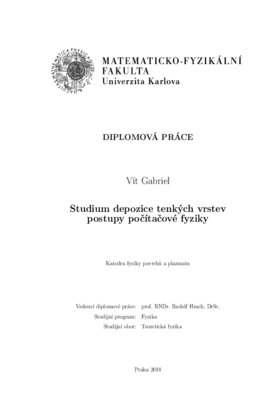Studium depozice tenkých vrstev postupy počítačové fyziky
Study of deposition of thin films by methods of computational physics
diploma thesis (DEFENDED)

View/Open
Permanent link
http://hdl.handle.net/20.500.11956/101022Identifiers
Study Information System: 179035
Collections
- Kvalifikační práce [11325]
Author
Advisor
Referee
Novotný, Dušan
Faculty / Institute
Faculty of Mathematics and Physics
Discipline
Theoretical Physics
Department
Department of Surface and Plasma Science
Date of defense
5. 9. 2018
Publisher
Univerzita Karlova, Matematicko-fyzikální fakultaLanguage
Czech
Grade
Excellent
Keywords (Czech)
tenké vrstvy, Monte Carlo, molekulární dynamikaKeywords (English)
thin films, Monte Carlo, molecular dynamicsTato práce je zaměřena na návrh a použití metod počítačové fyziky a metod zpraco- vání obrazu pro studium růstu tenkých vrstev. V první části práce věnované metodě molekulární dynamiky je vytvořen model růstu. Ten je poté použit na určení konfigurací ostrůvků, které mají méně než jedenáct atomů, a popis koalescence malých ostrůvků ob- sahujících řádově stovky atomů. Výsledky získané pomocí metody molekulární dynamiky jsou použity pro tvorbu modelu růstu tenkých vrstev metodou Monte Carlo. Tento model je následně použit pro simulaci při použití vakuového napařování se spojitým a přeru- šovaným tokem částic. Následně byly získané výsledky zpracovány metodami zpracování obrazu, konkrétně pomocí rozdělení poloměrů a metody Quadrat Counts.
This diploma thesis is focused on the design and application of computational physics and image analysis methods. These methods are then used to study early stages of thin films growth. The first section of this thesis is devoted to create molecular dynamics growth model. This model is used to determine the configurations of very small islands containing less than eleven atoms and to describe the coalescence of islands containing hundreds of atoms. The results from the molecular dynamics model are then used as input to the Monte Carlo model. The Monte Carlo model is then used to describe the continuous and pulsed vacuum evaporation methods. The obtained results from the Monte Carlo model are processed by image analysis methods, namely radii distribution and Quadrat Counts method.
